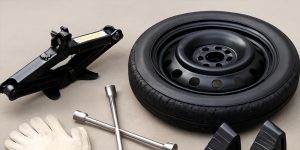
Flat tires are one of the most common roadside problems in the Philippines, especially with our unpredictable weather, rough roads, and heavy traffic. Knowing how to change a flat tire can save you hours of waiting for roadside help and keep you moving safely. Here is a detailed, step-by-step guide on how to change a tire.
In the Philippines, always stop in a safe spot — ideally on a flat concrete shoulder or parking area. Avoid stopping at blind curves, soft shoulders, or steep inclines. Turn on your hazard lights and, if possible, place your early warning devices (reflectors or triangles) about 3–5 meters behind your car to warn other motorists. Engage the parking brake and, if available, place wheel wedges opposite the flat tire.
Learn How to Check Tire Tread and Know When to Change Tires

Make sure your car is equipped with the following:
With the car still on the ground, use the lug wrench to loosen the nuts counterclockwise. They might be very tight, so you may need to use your foot or full body weight to break them loose. Do not remove the nuts yet. Remove the hubcap, if any, using a screwdriver or the back of the wrench. For cars with locking lug nuts, use the key included with your vehicle.
Locate the jack points indicated in your owner’s manual — usually behind the front wheels and ahead of the rear wheels. Place the jack securely and raise the car until the flat tire is about 6 inches off the ground. Never position the jack on soft soil, grass, or loose gravel.
Once raised, fully remove the loosened lug nuts and keep them in the hubcap or a secure pouch. Pull the flat tire straight off and set it flat on the ground so it doesn’t roll away.
Position the spare onto the wheel bolts, ensuring it sits snugly on the hub. Replace the lug nuts and hand-tighten them in a crisscross or star pattern to secure the wheel evenly.
Slowly lower the car until all four tires are on the ground. Remove the jack. Use the wrench to fully tighten the nuts in a star pattern for balanced pressure. This is critical to avoid wobbling while driving.
Use a tire gauge to check the spare’s pressure — many compact spares require 55–60 PSI. If the spare is under-inflated, drive cautiously to the nearest vulcanizing shop or use a portable inflator. Return all tools and the flat tire to your trunk and remove the warning devices before resuming your trip.
For high-quality spare tires, tools, and accessories that suit Philippine roads, visit KGCAR.PH. They offer a wide selection of automotive products delivered anywhere in the Philippines, making sure you’re prepared for any roadside emergency.
Being ready to handle a flat tire can save you from inconvenience and danger on Philippine roads. Equip your car with the proper tools, practice these steps, and always keep your spare in good condition.
Since 2012, KG Car PH has been the go-to for affordable car parts in the Philippines. We make it easy to find the right fit and offer same-day delivery nationwide—so you get quality parts fast, without spending more.
SOCIAL MEDIA
TOP CATEGORIES
QUICK LINKS
© 2025 KGCAR.PH